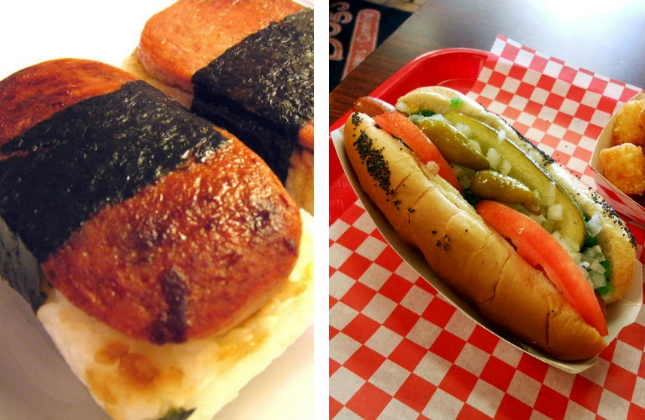When it comes to processed meats in Chicago, it's clear who reigns supreme: an all-beef frank (on a poppy seed bun, topped with sliced tomatoes, bright green relish, sport peppers, chopped onions, a kosher-style pickle spear, and a sprinkling of celery salt).
Is there room in our hearts for Spam?
The “SPAMerican tour” rolled into town last weekend to test just that. The branded bus stopped by Windy City Smokeout and offered unique creations like Spam musubi (a sushi-like dish), Spam fries, and Spam biscuits and gravy.
The reception? Not too bad. Katie Shutt, who moved to Chicago from Minnesota two and a half years ago, said she holds a special place in her heart for Spam. “Everyone has the perception that Spam is like this nasty canned ham,” she said, “but when you mix it up and present it in a different way, I think it serves for a more premium experience.”
Presentation makes a big difference. If not for the can vs. sausage casing format, the Chicago-style dog and Spam might well be cousins. They were both born in the 1930s. Though the hot dog itself was first introduced at Chicago's 1893 Columbian Exposition, Vienna Beef says the classic Chicago dog was a favorite Depression-era food. Hot dog vendors sold the “salad on top” hot dogs from their carts for a nickel a piece. Spam followed in 1937 and became another low-cost staple in pantries across the country.
And Spam isn't unheard-of in Chicago restaurants now. Lincoln Park's Aloha Eats serves up Spam dishes on its menu of Hawaiian staples. Ivan Lee, part owner, said he understands some people have a visceral reaction—even insulting the protein while others nearby are eating it—but that most people who decide to try it are pleasantly surprised.
Chicagoans are "pretty adventurous food people," he said. "Eventually they'll get [convinced] to try it."
At the Spam fest this weekend, we visited Chicago chef Gale Gand (Tru, Spritz Burger) to find out what the famed local pastry chef cooked up using the maligned meat. She was serving cinnamon-crusted Spam waffles with caramelized Spam and apricot jam. “In my mind,” Gand said, “it’s the classic Chicago combination of salty and sweet.”
She was right: The dish sandwiched the two flavors—sweet waffles, salty Spam, and sweet jam—to get a bit of each in every bite. Not bad for having started in a can.
Growing up in north suburban Deerfield, Gand said her home was more likely to have Spam than hot dogs on the dinner table. Spam is an American tradition, she said. She even has pictures of herself standing in front of the giant can of Spam in Austin, Minnesota.
“It’s so iconic,” she said. “It’s like Andy Warhol.”
An informal poll taken near the "SPAMerican" bus at the Windy City Smokeout suggested not many felt the same. Though plenty of people ventured to try the dishes, very few would abide by a comparison between the city's official processed meat and the canned interloper.
Drew Fox (team Spam) and his girlfriend, Hannah Chung (team hot dogs), debated the finer points.
“Well, you can grill Spam,” Fox said to her.
“True, and make it into a hot dog," she retorted.
In fact, the idea seemed to be pretty popular. For all the creative uses of Spam presented this weekend, none of the options included a poppy seed bun.
Shutt, the Minnesotan, ventured, “If they can do it with sushi, I’m sure they can do it with a hot dog."
Perhaps Chicago’s preference for processed meat comes down to that: Spam in a can? No thanks. Spam on a hot dog bun? Roll it up, grill it, and drizzle some mustard on that baby.
But for the love of God, just don’t put ketchup on it.



